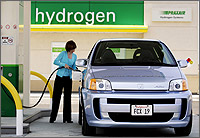![360px-CBX_Parkchester_6_jeh[1]](https://alankandel.scienceblog.com/files/2012/12/360px-CBX_Parkchester_6_jeh1-e1371323265825.jpg)
The primary difference between that report and today’s is today’s looks at year-over-year traffic congestion comparison data for two years – 2012 and 2013 – but only for April. Information was obtained from INRIX in its “Latest Index of Traffic Congestion Shows Risk of Uneven Recovery in the U.S. Economy” press release. On the other hand, the “Fifty years of American commuting” report considered data covering 1960 to 2009, not all years mind you, only 1960, 1970, 1980, 1990, 2000 and 2009.
Meanwhile, some main highlights of the “Fifty years of American commuting – 1960-2009: What the numbers say” report are:
- Suburban workers commuting solo by car: 81.5 percent
- Urban “principal city” workers commuting solo by car: 72.1 percent
- In 2009, 119,393,000 commuted in cars, trucks and vans; 12,064,000 commuted on foot, on public transit and via other means
- Between 1960 and 2009, about 79 million more motor vehicle commuters were added to the mix or a 65.7 percent increase
On the other hand and not surprisingly, gridlock on U.S. roads overall grew by 9.4 percent April 2013 versus April 2012, according to INRIX. This is “the second largest year-over-year increase recorded by the [INRIX Gridlock Index].”
“This means the average trip took drivers in the 100 most populated metro areas nearly seven percent longer because of increased traffic congestion, a side-effect of better economic times,” INRIX reported.

An improving economy and hence a corresponding increase in not only motor vehicle traffic but domestic waterway navigation, railroad and aviation activity, could result in further damage to the air on account of upped transportation emissions. However, this could be offset by:
- Adding capacity: This could involve expanding roadway, railway, etc., infrastructure
- Altering development and land-use patterns: This could involve greater reliance on compact, mixed-use, location-efficient (i.e., residents and jobs closer together), transit-oriented development
- Altering employment patterns: This could involve changing the way people travel to work, such as offering four-day work weeks, changing the times employees report to and leave work and a greater reliance on telecommuting or teleworking
- Improving transportation management: This could involve greater controls over how traffic moves, such as offering high-occupancy toll (HOT) lanes, signalized (metered) freeway on-ramps, etc.
- Improving technology and fuels: This could involve shortening the distance between vehicles traveling the same direction on a given corridor while ensuring safe operation, or, in the case of fuels, promulgation of biofuels
- Offering options: This could involve greater dependence on public transportation, walking, biking, etc.
(For more, see: the 2012 Urban Mobility Report, the section on: “Congestion Relief – An Overview of the Strategies,” from the Texas A&M Transportation Institute, in 2012, on p. 17, here).
How we move about obviously affects emissions. Finding ways to reduce emissions all the while making transportation more efficient and not negatively impacting the U.S. economy will be the trick. Doing this will, no doubt, be a challenge but one definitely worth pursuing and overcoming in my view. The public is the ultimate beneficiary here. That, too, is obvious.
This post was last revised on Sept. 26, 2020 @ 5:38 a.m. Pacific Daylight Time.
– Alan Kandel